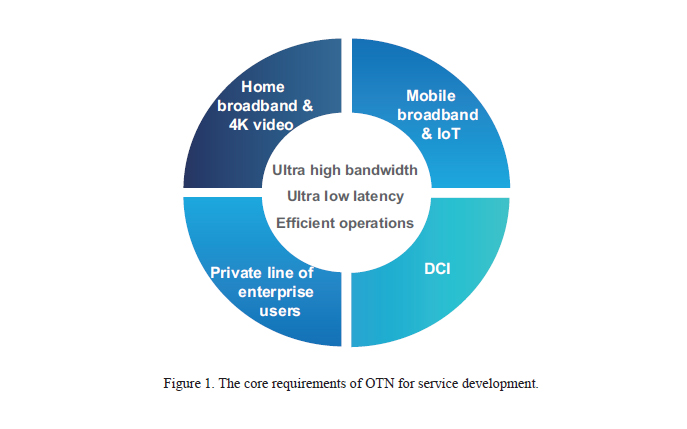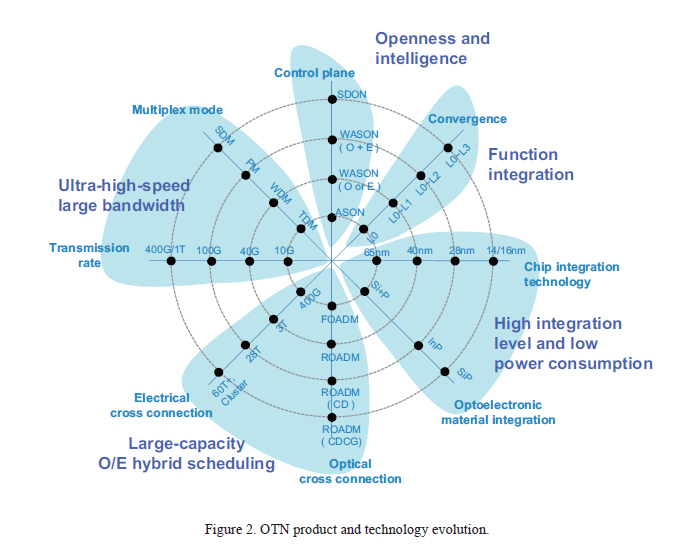Service-Driven OTN Evolution
In recent years, video has gradually evolved from being operators' value-added service to being their basic service. Video has also become a main driving for new broadband. Video services have three characteristics: high traffic, high bit rates, and high user experience. The current popular 4K videos require a bandwidth of 30 to 50 Mbps, while VR needs a bandwidth of more than 200 Mbps.
Video traffic is directly carried by fixed and mobile broadband networks. Basically, fixed broadband rate increases tenfold every seven years. Driven by video services and the "Broadband China" strategy, fixed broadband access rate rises up to 100 Mbps and will reach 1 Gbps in the future. Mobile broadband evolves to Pre5G and 5G, with a 1,000-fold increase in traffic density, 100-fold increase in peak rates and 100-fold increase in connection density. The private line bandwidth of enterprise users is also upgraded from 10–100 Mbps to 100 Mbps or above GE. In the future, networks will be centered on data centers (DC), operators will compete to build cloud data centers, high-speed backbone networks will provide direct inter-IDC routes, central office (CO) reconstruction will promote the deployment of metro edge DC and regional DC, and high-speed large-bandwidth OTN will work as an inter-DC link. Being the infrastructure layer to carry these services, OTN must meet the first requirement on ultra-high bandwidth transport.
The second requirement is low latency. Internet of vehicles (IoV), telemedicine and other new applications have the strict latency requirements. Also, the latency requirements for finance and other industries cannot be ignored. High-frequency financial transactions require a latency less than 1 ms, DC disaster recovery requires a latency less than 10 ms, industrial control a latency less than 10 ms, and 4K videos a latency less than 25 ms. If the service requires a low latency, there will be smaller time delay allocated to the transport system but higher requirements for the transport network. In other words, latency is money, it is a lifeline, it is user experience, and it is more about network performance.
The third requirement is operations management. Future network traffic flows and directions will be faster than those of today's networks, and there will be larger network scale. These require that OTN should be easy to deploy, easy to adjust, and easy to converge, so that it can carry multiple services, respond quickly to service demands, increase resource efficiency, and support multi-domain synergy and interconnection for rapid service innovation.

To meet the core requirements of OTN for future service development (Fig. 1), ZTE needs to consider developing its OTN products and technologies.
Ultra-High Bandwidth
100G and beyond-100G technologies are available to address the requirement for ultra-high bandwidth. 100G optical networks have been deployed on a large scale for several years and have achieved an unprecedented success, and now they are still optimized. In the backbone network, the performance of 100G long-haul transport is continually improved. ZTE has developed the third generation SD-FEC that provides 25% redundancy and back-to-back OSNR tolerance of 10 dB. This greatly extends transport distance, increases backbone direct circuit connectivity, and reduces electrical relay cost and service delay. In the metropolitan area network, ZTE has launched low-cost 100G interconnection solution that uses photonic integration, bandwidth expansion of low-speed optical transceivers, new modulation and compensation algorithms. The solution provides lower cost than a coherent system and has advantages in short- and medium-haul transport. Since the current 100G equipment chips and optical modules get smaller and smaller in size and consume less power per bit, small-sized 100G OTN equipment has such a promising market prospect that 100G high-speed interconnection can be extended to the metro edge.
With the growth of traffic flow, the maturity of 400GE and beyond-100G OTN standards, and the establishment of related industrial chain, beyond-100G line transport is just around the corner. The beyond-100G increases symbol rates, the number of bits per symbol, and the number of sub-carriers by balancing system capacity, transport distance and component performance. Depending on application scenarios, there are a variety of beyond-100G solutions including 200G single-carrier PM-16QAM, 200G single-carrier PM-8QAM, 400G dual-carrier PM-16QAM, and 400G quad-carrier PM-QPSK. In the beyond-100G stage, optical modules adopting the silicon optical technology will have small size, consume less power, and support an ultra-high-speed system. For long-haul trunks, the transport distance without electrical relay can be extended by using hybrid amplifiers composed of Raman OA and low-noise EDFA or by deploying low- or ultra-low-loss fibers in the trunks. These technologies can improve spectrum efficiency, increase transport capacity, and guarantee a transport performance equivalent to the 100G system.
ZTE has scored significant achievements in the ultra-100G field. In June 2015, ZTE transmitted 400-Gbps signals via OFS ultra-low-loss fiber for a distance of 10,130 km, setting a new world record. ZTE's 400G system has been commercially deployed, and there also have been its success cases about transport of 10G/100G/400G hybrid signals.
Large-Capacity Hybrid Optical/Electrical Switching
In addition to line rates, cross-connect capacity also needs to increase. Large electrical cross-connect capacity makes it easy to implement non-blocking grooming and scheduling of the traffic of different granules. For example, the 28T cross-connect capacity can schedule a total of four to five lines of traffic, with 40-wavelength 100G traffic in each line. The electrical cross-connect capacity of a single rack can rise to above 60T, and future multi-rack cluster will extend its cross-connect capacity to more than 400T. As the electrical cross-connect capacity of a rack grows, its power density also increases although the power consumption per bit drops. When electrical cross-connect capacity further increases, it is difficult to address the power supply and heat dissipation issues under existing equipment room conditions, and the operating cost is also relatively high. Optical cross-connection has therefore drawn more and more attention. A reconfigurable optical add/drop multiplexer (ROADM) provides reconfigurable channel scheduling capability to meet the needs of dynamic traffic, improve network architecture, reduce the processing cost and capacity pressure at the electrical layer, and to significantly cut down high power consumption caused by electrical regeneration and cross-connection. According to different application scenarios such as metro area network, chain trunk, ring trunk and regional networking, ROADM needs to analyze different models and select different configuration combinations such as wavelength independence, direction independence, conflict independence, and arbitrary grid, to get the optimal result between network flexibility and cost. In the future, hybrid optical/electrical cross-connection will become an important feature of optical network nodes.
Multiservice Bearing Capability
OTN also needs to have multiservice bearing capability. Traditional OTN equipment only supports L0 and L1, while new-generation OTN equipment supports L2 packet functions. TDM, fixed bit rates, and IP/Eth services sharing no bandwidth are transmitted via L0/L1 rigid lines. After the convergence, 10M–100M small-granule services carried over the original MSTP can also be transferred to OTN. These services are scheduled and physically isolated according to wavelength or ODUk sub-wavelength to ensure performance and security. The services that have IP/Eth variable bit rates or share bandwidth are carried via elastic packet lines. Although they are carried via elastic packet lines, their QoS is guaranteed. Services can be distinguished by labels and scheduled by service priority to meet different needs for delay, jitter and bandwidth. Therefore, the OTN platform with overlaying packet functions can provide a unified transport line that features rigidness, elasticity, and guaranteed performance.
Ultra-Low Latency
Some optimizations such as path optimization, layer optimization, networking optimization and equipment optimization must be done to meet the needs for carrying low-latency services.
● Path optimization: Optimize optical paths, reduce alternate paths, and choose the shortest fiber path and the least forwarding nodes.
● Layer optimization: Since high-layer protocol processing results in greater latency, services are recommended to be processed and forwarded at the low layer. Protocol processing at the optical layer is faster than that at the electrical layer.
● Networking optimization: Flat networking or grid networking allows fewer layers to be used and can also avoid hop-by-hop forwarding.
● Equipment optimization: It is necessary to optimize optical modules and components for internal forwarding, processing, and interconnection. This can greatly reduce the total latency and support more latency-sensitive services.

Efficient Operations
SDN is certainly the main technological means for high-efficiency operations. The SDN-based OTN brings a flexible, intelligent, efficient, and open network. ZTE has cooperated with China's operators to develop and test BoD and OVPN applications, hoping to rapidly deploy services, reduce operational manpower and improve tenant experience in the cross-domain, cross-vendor network environment. The next step is to gradually run commercial trials. ZTE has also worked with overseas multinational operators for joint innovation in IP and optical synergy, aiming to cut network Capex and Opex in the scenarios of cross-layer service planning and distribution as well as high-volume IP traffic bypass. Large internet companies are also ZTE's important partners. ZTE and China's major ICPs have jointly developed DCI bandwidth scheduling to meet the needs of cloud services.
In general, the development of new services has put forward three core requirements for OTN: ultra-high bandwidth, ultra-low latency, and high-efficient operations. The evolution of OTN product and technology needs to meet these requirements in five aspects including ultra-high-speed large bandwidth, large-capacity optical/electrical hybrid scheduling, high integration level and low power consumption, function integration, and openness and intelligence (Fig. 2). New networking ideas are also necessary. In the future, OTN will maintain long-term rapid development and there will be more innovations and changes.